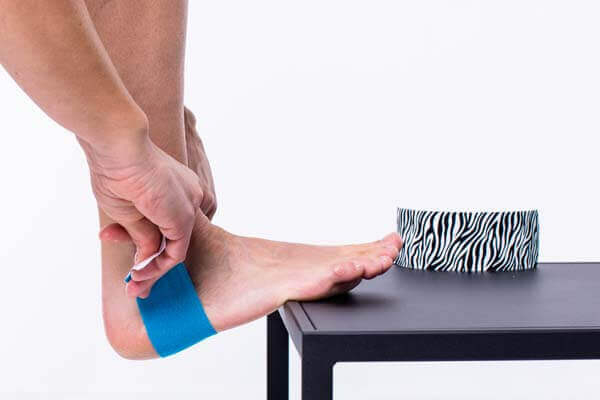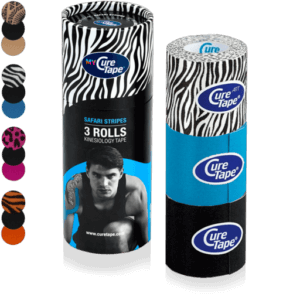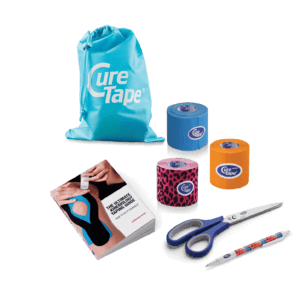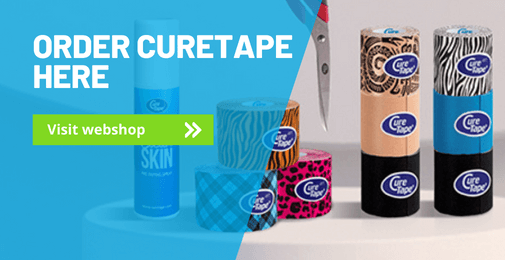A typical symptom of plantar fasciitis is pain in the area of the heel. This occurs especially in the morning after getting up, or after prolonged sitting and standing. Often a strong, stabbing pain is felt and you can hardly put any weight on the foot. Heel spur is usually caused by excessive or one-sided strain on the foot, e.g. due to incorrect footwear during sports, obesity, or an incorrect position of the foot. If the foot is loaded incorrectly over a longer period, the body reacts by producing calcium at the affected tendon attachments under the foot, which provides stability. This is actually a first-aid reaction of the body, but these calcium deposits cause a stinging pain and the area often becomes inflamed. The tape application shown here can help you reduce the pressure on the heel area and the point of pain. The surrounding tissue is supported and the inflammation can therefore heal.
How to tape plantar fasciitis
Tips for a good foot taping application:
- Is the cause of the complaint or pain clear?
- Check if there any contraindications for not taping.
- Before you start taping, carefully read the instructions.
- Choose a colour of tape, any colour that fits your mood!
- Round of all the edges to prevent peeling.
- Do not stretch the tape at the beginning and the end.
- Rub the tape well for adhesion. Heat activates the adhesive layer.
- Showering or swimming is possible, pat the tape dry after it gets wet. Do not rub it hard.
- It is easier to remove the tape with body or massage oil.

Christina’s advice when taping your foot
In the self-taping instructions, I have chosen taping applications that are easy to apply yourself. In order to make this treatment safe, I give practical tips, which you should take into account before, during and after a tape treatment. They are based on my years of practical experience. If the complaints persist, always consult a therapist or doctor.
Instructions
Tape
Shape:I-Tape.
Number of strips: 2.
Technique: ligament technique (maximum/full stretch).
Measuring and cutting the tape
Step 1:

- Place the foot on a chair and press the heel down. Measure the length of the tape from the bottom of the heel to the edge of the ankle on each side.
Applying the tape
Step 1:

Step 2:

Step 3:

- Tear the release paper in half and fold it over on both sides.
- Apply the centre piece under the heel, with maximum stretch, and place the tape with stretch direction along the sides of the Achilles tendon.
- The second tape is applied overlapping the first tape by approximately 1 cm in the same way.
- Finally, gently rub the tapes together. After applying this tape, you should immediately notice a pain-relieving effect. The pain point is relieved – comparable to a gel cushion under the heel.
Popular products to tape your foot
-
MYCureTape® – 3 Rolls Kinesiology Tape – Value Pack
 $26.95
In stockSelect options This product has multiple variants. The options may be chosen on the product page
$26.95
In stockSelect options This product has multiple variants. The options may be chosen on the product page -
Book: The Ultimate Kinesiology Taping Guide
 $29.95
In stockAdd to cart
$29.95
In stockAdd to cart -
CureTape® Ultimate Self-Tape Starter Kit
 $87.95
In stockAdd to cart
$87.95
In stockAdd to cart
Learn how to tape
- 30 taping instructions for common injuries that taping can help you with
- 176 pages of clear written instructions
- 200 step-by-step instructions accompanied by photo’s, illustrations and scannable video’s through QR codes
What are you waiting for? Order your copy today!
*This book is intended for people who want to tape an injury or complaint themselves. If uncertain about the complaint, consult a physiotherapist.
THYSOL is the manufacturer of the kinesiology tape brand CureTape. As CureTape, we have been training and supplying professionals for almost 25 years. And consumers now know how to find us too! By manufacturing all our tapes in our own factory, we can guarantee the best quality!
Please note that the indicated tape applications and information on our website about the possibilities with kinesiology tape have not yet been scientifically proven. The statements and examples mentioned are based on long-term experiences of patients and trained therapists.
Contraindications not to tape: pregnancy, open wounds, broken bones, unexplained complaints, allergies and skin diseases, use of medication such as blood thinners, thrombosis and fever. Always apply tape in consultation with a specialist.






